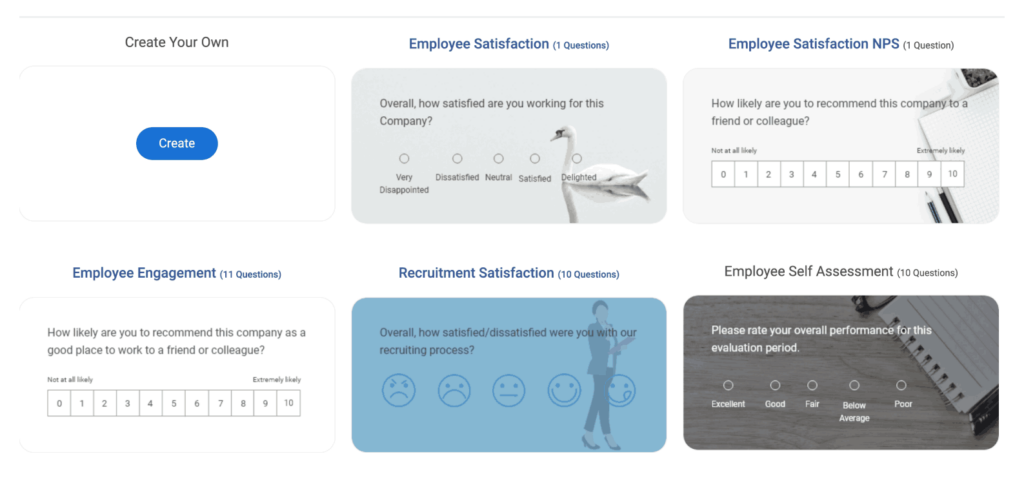
It’s always tough to see top talent go. But their departures can be a goldmine of insights if we ask the right questions. That’s where employee exit surveys come in. They help us understand why employees leave and show us how we might keep others from doing the same.
What should you ask in these surveys? How do you make sense of the answers? What’s next after you get the insights?
In this blog, we’ll provide you with over 30 key questions to include in your exit surveys and explore ways to use this information to keep your best people engaged and improve your workplace.
Watch: 6 Quick Tips to Create Awesome Employee Engagement Surveys
Ready to learn more? Let’s dive in!
What are Employee Exit Survey Questions?
An employee exit survey is like a final one-on-one conversation with your departing employees, but instead of a chat, it’s a structured questionnaire that asks specific questions to find out the real reasons they’re leaving.
These questions are a chance to get honest feedback about what might be simmering beneath the surface of your workplace—things you might not see or hear about during day-to-day operations.

When an employee leaves, it’s not just a vacancy you’re looking at; it’s an opportunity to learn. What drove them away? Was it the work environment, the management style, their pay, or perhaps the lack of opportunities for advancement?
The answers can be eye-opening. They not only help you understand what might be going wrong but also give you a chance to make changes that could prevent further turnover.
What Should You Ask in an Employee Exit Survey? 30+ Examples
We have arrived at the good part now! Let’s look at some of the best employee exit survey questions you can ask your departing employees to comprehensively analyze your institution’s strengths and weaknesses.
You can use these questions as is or mix them up for more well-rounded data.
1. General Feedback
These questions aim to gather a broad understanding of the employee’s overall experience, offering insights into the company’s culture and day-to-day operations. It’s about more than just their last day—it’s about understanding what worked, what didn’t, and the overall impact of your organizational culture on their professional life.
General feedback questions help paint a comprehensive picture of an employee’s journey within the organization, tapping into both the tangible and intangible aspects of working at the company, such as cultural fit, communication styles, and overall satisfaction with the work environment.
What kind of feedback can you get with these questions?
- Overall Experience: Gauging the general satisfaction or dissatisfaction with the company as a whole.
- Cultural Alignment: Understanding how well employees feel they fit into the company culture.
- Resource Availability: Assessing whether employees had the tools and resources they needed to succeed in their roles.
- Management Communication: Evaluating how effectively information is shared and whether communication is clear and timely.
- Personal Alignment: Looking at how well the employee’s personal values and career goals aligned with their job and the company.
- Fairness of Policies: Insights into perceptions of fairness concerning company policies and their implementation.
- Return Potential: Whether the employee would consider rejoining the company under different circumstances.
- Descriptive Insights: Encouraging employees to summarize their experience or describe the company in a few words to capture the essence of the company’s environment.
Example Questions
- How would you describe your overall experience working with us?
- What did you like most about your job?
- What prompted you to start looking for a new job?
- Were there any company policies you found difficult to comply with?
- How do you feel about the way management communicates with the staff?
- Did you feel that the work you were doing aligned with your personal goals and interests?
- How fair do you feel our performance review process was?
- Would you consider returning to work here in the future? Why or why not?
- Did you have the tools and resources needed to effectively do your job?
- What three words would you use to describe our company culture?

2. Specific Reasons for Leaving
This category focuses on understanding the specific triggers for the employee’s departure, which is crucial for addressing issues that might impact retention. Understanding these reasons helps you to pinpoint issues that may be lurking under the surface, potentially affecting other employees as well.
Understanding the specific reasons behind an employee’s decision to leave allows the company to address these issues directly. It helps identify and rectify problems that are within the company’s control, potentially reducing future turnover.
What do these questions reveal? Let’s see:
- Job Offer Comparison: Reasons why another job offer was more appealing than the current position.
- Work-Life Balance: Satisfaction with the balance between work responsibilities and personal life.
- Recognition and Rewards: Feelings towards the acknowledgment and compensation received for work done.
- Job Satisfaction Changes: How and why the employee’s job satisfaction changed over time.
- Unresolved Issues: Any ongoing concerns that were not adequately addressed by management.
- Professional Growth: Opportunities for advancement and professional development that were or were not provided.
- Expectations vs. Reality: Whether the job responsibilities met the expectations set during the hiring process.
- Improvements Needed: Specific changes the employee believes could make the position more attractive.
Example Questions
- What are the key factors that led you to accept another job offer?
- Were you satisfied with the work-life balance here?
- Did you feel that your achievements were recognized and rewarded adequately?
- How could your job have been more satisfying?
- What could have been done for you to remain employed here?
- Were there any unresolved issues that influenced your decision to leave?
- How would you rate your professional development opportunities with us?
- In terms of job satisfaction, how has your role changed since you started?
- Were your job responsibilities what you expected them to be when you were hired?
- How do you think your job could be improved?
- Did you feel that the managerial staff supported your career development?
- Were there any specific incidents that led to your decision to leave?
- What did you dislike most about your job or the company?
- Is your exit from this company motivated by any interpersonal relationships here at work?

3. Employee Net Promoter Score (eNPS)
Employee Net Promoter Score measures an employee’s willingness to recommend your workplace to their friends or family. This metric provides a quick snapshot of employee loyalty and satisfaction, distilled into a single, powerful figure. The questions in this category are designed to gauge the overall sentiment about working at your company, which can serve as a barometer for your internal health.
What can you know with eNPS Questions?
- Likelihood of Recommendation: Whether and how strongly employees would recommend the company as a workplace.
- Influencing Factors: The main reasons behind their score, whether positive or negative.
- Company Values: Alignment with and perceptions of the company’s core values and mission.
- Growth Opportunities: How the potential for personal and professional growth influences their recommendation.
- Cultural Fit: The impact of company culture on their willingness to recommend the workplace.
- Improvement Suggestions: Specific areas where the company could improve to enhance employee satisfaction and increase the eNPS score.
- Overall Sentiment: The general feeling or mood the employee associates with the company and its environment.
Example Questions
- On a scale of 0-10, how likely are you to recommend our company as a place to work?
- What could we do to improve your rating?
- What are the key factors that influenced your score?
- How do you feel about the growth opportunities within the company?
- What changes would make you more likely to recommend us?
- Did the company culture meet your expectations?
- How well do you think our company values its employees?
- What would you improve about the company culture?
- How effective do you think our team-building efforts were?
- Would you describe our workplace as inclusive and accommodating?

4. Employee Satisfaction (eSAT)
eSAT questions are designed to measure satisfaction levels across several key workplace dimensions, including compensation, job security, leadership, growth opportunities, and company culture. These insights help pinpoint strengths to be leveraged and weaknesses that require intervention.

Areas where eSAT questions can help you:
- Compensation and Benefits: Understanding whether employees feel fairly compensated in terms of salary and whether the benefits package meets their needs and compares favorably with industry standards.
- Job Security: Gauging how secure employees feel in their positions, especially in volatile industries or times of organizational change.
- Leadership and Direction: Assessing how employees perceive the effectiveness and clarity of leadership and the company’s strategic direction. This includes whether leadership is inspiring, fair, and transparent in their dealings.
- Growth Opportunities: Measuring satisfaction with professional development opportunities and the ability to advance within the organization.
- Workplace Wellness and Support: Evaluating how supported employees feel by policies and practices that promote work-life balance, mental health, and overall well-being.
- Feedback and Recognition: Understanding how feedback is given and whether employees feel recognized for their contributions can significantly affect satisfaction levels.
- Collaboration and Team Dynamics: Looking at how employees rate their interactions and cooperation with colleagues and if the workplace fosters a collaborative spirit.
- Handling of Grievances: Getting feedback on workplace issues and conflicts are handled, which significantly impacts workplace morale.
- Flexibility: Satisfaction with the flexibility of work arrangements, such as telecommuting options and flexible working hours.
- Training and Development: Insights into how well the company supports ongoing learning and skill enhancement through training programs.
Example Questions
- How satisfied were you with your salary and benefits package?
- Rate your satisfaction with the job security at our company.
- How satisfied were you with the leadership and direction of the company?
- Were you satisfied with the opportunities for personal and professional growth?
- How would you rate your satisfaction with the support provided for employee wellness?
- Did you feel the performance feedback you received was constructive and fair?
- How satisfied were you with the collaboration opportunities within your team?
- Rate your satisfaction with how the company handles employee grievances.
- Were you satisfied with the flexibility offered in terms of work hours and remote work options?
- How satisfied were you with the training and development programs offered?

How to Ask the Best Exit Interview Questions: 7 Tips and Techniques
Crafting an effective exit survey is more than a routine HR task—it’s a chance to gain invaluable insights that can transform your workplace. Here’s how to create a survey that resonates with departing employees and provides you with data you can really use:
Keep It Relevant and Concise
While it’s important to gather comprehensive data, the survey should also respect the respondent’s time. Your questions should hit the mark—ask about experiences and reasons that matter to both the employee and your organization. Keep your survey concise; clear, direct questions to increase the likelihood of them completing the survey thoughtfully. A well-designed survey should typically take no longer than 10-15 minutes to complete.
Guarantee Anonymity
Honesty is crucial, and it becomes easier when employees know their responses are anonymous. Assure them that their feedback is a tool for positive change, not a session for personal critique. This way, you’ll get the truest insights into your organizational climate.
Mix Up the Questions
Blend rating scales, multiple-choice, and open-ended questions to keep the survey engaging. While structured questions quantify attitudes, making analysis simpler, open-ended questions go deeper and tell you the story behind the scores.
Time It Right
Conduct the survey close enough to the departure date to be fresh but not so close that raw emotions cloud the feedback. This timing helps capture reflective and balanced insights about their entire experience, not just their exit.
Act on the Feedback
What you do after the survey matters most. Develop a clear process for analyzing the feedback you receive and implementing changes based on it. Let employees know that their insights are catalysts for real change—it’s not just data collection but a step towards a better workplace.
Regularly Update Your Survey
Business changes, and so should your survey. Regularly revisiting and revising your questions keeps them relevant and ensures you are always gathering data that reflects current challenges and contexts.
Make It Accessible
Ensure every departing employee can easily access the survey, whether they are in-office or remote. Utilizing digital platforms accessible from any device broadens participation and ensures you hear from everyone.
What Are the Benefits Of Using Exit Survey Questions?
Used right, exit survey questions can transform what might seem like a routine procedure into a strategic tool to nurture a positive workplace culture.
Here are some factors why these surveys are significant for any workplace:
Uncover Hidden Insights
Exit surveys reveal the real sentiments employees might not express during their tenure. These insights go beyond day-to-day conversations and can uncover systemic issues that may not be visible through other means.
Whether it’s a recurring problem with management style, unexpected feedback about workspace design, or deep-seated issues with company culture, these surveys can bring critical issues to light before they affect more of your team.
Enhance Employee Retention
Understanding why employees leave allows you to make targeted adjustments to keep your top talent. By acting on the trends and patterns revealed through exit surveys, you can address the root causes of turnover and create a more stable and engaging work environment.
Improve Onboarding and Training
Feedback from departing employees often includes their experiences with onboarding and ongoing training programs. This feedback is gold for refining your approaches to training new hires and developing your staff, ensuring that all employees are better equipped to succeed and stay longer.
Strengthen Employer Branding
Exit surveys contribute to a culture of openness and continuous improvement. By asking for feedback and showing that you value it, you reinforce a positive image of your organization as a place that cares about its employees.
This can enhance your reputation in the job market, making your company a more attractive place to work.
Boost Employee Engagement
Knowing that their opinions will be sought and valued even as they exit, current employees might feel more engaged and committed to their roles. They see a pathway for their voice to be heard, not just in exit surveys but in other aspects of their work life, fostering a more inclusive and responsive workplace.
Guide Strategic HR Decisions
The aggregated data from exit surveys provide a strategic lens through which HR can view the organization. This data informs broader HR strategies and initiatives, from refining recruitment practices to enhancing employee development programs, ensuring that decisions are data-driven and aligned with employee needs.
Leverage Employee Exit Surveys to Retain Top Talents
As we wrap up our exploration of employee exit surveys, it’s clear that they are much more than a final checkbox on an employee’s departure checklist. These surveys are powerful tools that offer profound insights into your organization’s inner workings.
By strategically utilizing the feedback from these surveys, you can make meaningful changes that boost morale, enhance retention, and strengthen your company’s culture.
Embrace exit surveys as a critical feedback mechanism. They provide honest assessments that can help refine your practices, from onboarding to ongoing development and beyond. To create a perfect employee feedback loop, begin by choosing a survey tool that offers a pre-built professional employee exit survey template. Then, you can tailor the questions to fit your needs.
Take these insights, use them to craft a better environment, and watch as your organization grows not just in size but also in quality and reputation.
Get a demo or sign up for free to explore employee exit surveys more!
Learn More About Exit Survey Questions
When to conduct an exit survey?
Conduct exit surveys one to two weeks before an employee’s last day to capture honest feedback while their experiences are still fresh.
Why should an organization use an exit survey?
Exit surveys provide critical insights into workplace conditions, reveal why employees leave, and offer actionable data to improve retention and satisfaction.
How do you get real insights from exit survey questions?
To extract genuine insights, ensure anonymity, use a mix of open-ended and quantitative questions, and create a comfortable environment that encourages honesty.
How long should an exit interview be?
An exit interview should ideally last between 30 to 60 minutes. This duration allows enough time to gather comprehensive feedback without overwhelming the departing employee.
FREE. All Features. FOREVER!
Try our Forever FREE account with all premium features!







